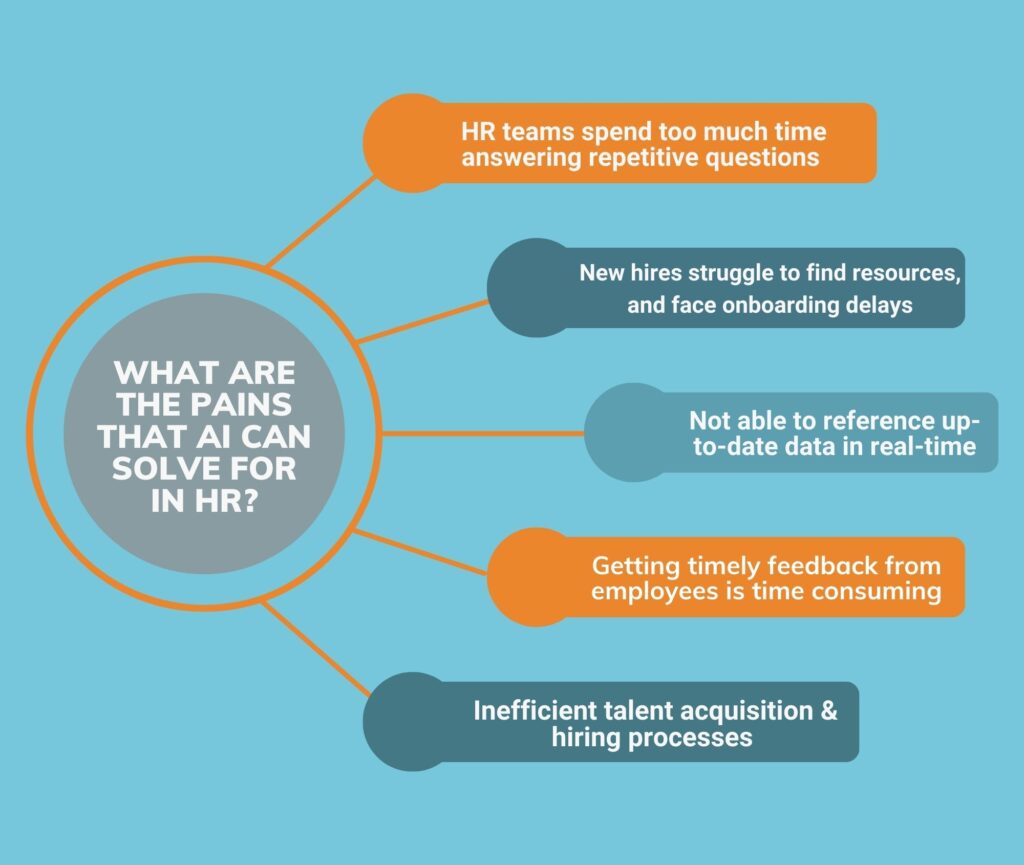HR teams are under more pressure than ever—reduced headcount, tighter budgets, and growing expectations from the leadership team. Meanwhile, employees still need to be onboarded, trained, and supported, to ensure retention and maximize their value to the organization.
AI solutions may promise to automate routine HR tasks, streamline operations, surface data and insights faster. But how do you ensure you’re investing in the right solution?
In this three-part series, we’ll guide you through what to consider when purchasing AI for HR, from defining your needs to evaluating vendors to ensuring successful adoption. Not all AI is created equal. Some solutions truly drive efficiency and improve the employee experience, while others create more headaches than they solve. We’ll cover everything from defining your needs, creating a budget and business case, to selecting the right vendor and ensuring a smooth rollout.
**This is Part One in a three-part series
Part One: Defining Your AI Needs & Goals
Before requesting a budget and evaluating vendors, you need to identify the HR challenges AI can solve. First, set clear objectives and desired outcomes and understand the different types of AI solutions available. Then gather your key stakeholders (from your manager, the head of your business function, and team members from other departments/teams), as starting with a collaborative approach is key. Let’s go!
1. Identify the Pain Points AI Solves for HR
Start by assessing the challenges your HR team and employees face. Common pain points that AI can address include:
- Manual and Time-Consuming Tasks: Data entry updates, creating reports or surveys, responding to emails, and updating systems are inefficient uses of our time. Use tools to track your time spent on various tasks in your work day. This can be as simple as a daily journal, an excel spreadsheet to track your time, or even AI tools that monitor your activities.
- HR Workload & Response Times: HR teams often spend excessive time answering repetitive employee questions about payroll, benefits, IT, or policies…and even coaching people managers.
- Employee Experience & Accessibility: Employees expect 24/7 access to HR support, especially in remote and global workforces. Companies struggle to communicate and gather feedback from employees, within the flow of work
- Compliance & Accuracy: Keeping up to date with changing legal regulations and ensuring accuracy of the information we share back to the business and employees is challenging. Managing internal content and knowledge is ongoing.
- Managing KPI Metrics: From time to hire, employee headcount, performance management, turnover/attrition, and employee engagement, producing reports “after the fact” do not produce actionable insight.
Action Step: Conduct internal surveys or interviews to identify the most time-consuming HR tasks and areas of employee frustrations. Analyze what tasks are time consuming and results in less time spent on more value added tasks.

2. Setting Clear Objectives
Once pain points are identified, define measurable objectives for implementation. Examples include:
- Efficiency Goals: Reduce HR inquiry response times by 50% and improve employee satisfaction by 18% from 2024.
- Cost Reduction: Lower operational costs by 12% by automating manual work and tasks in one year.
- Employee Engagement: Improve employee retention through automated communications, to keep employees abreast to changes, reducing turnover by 3% month-over-month.
- Compliance & Risk Mitigation: Ensure 100% consistency in policy-related HR responses, reducing Employee Relations cases by 6% in 12-months.
Action Step: Align AI goals with broader HR and overall business objectives to secure leadership buy-in. Take a look at our blog post on breaking down the silos between HR and Finance teams.
3. Understanding AI Capabilities
Not all AI solutions are created equal. Understanding the differences will help you choose the right technology:
- Robotic Process Automation: Rule-based bots that follow predefined scripts and decision trees. They work well for simple tasks, but struggle with complex, nuanced work flows.
- AI Chatbots: Using Generative AI and Retrieval Augmented Generation (RAG) combined with AI models based on machine learning and human-supervised training, AI Chatbots answer complex queries, for automating employee support services.
- AI Agents: Advanced AI solutions that leverage various types of AI to automate work flows and provide contextual, conversational responses as they learn over time.
- Hybrid Solutions: Some vendors offer a mix of rule-based and AI-powered automation to balance accuracy and control, often referred to as “guardrails,” to ensure AI compliance.
- Compliance and Security: This should actually be top of the list, as it is key to understand how AI works, learn about the ways to use AI responsibly, ensuring the solution meets your company’s needs for ethical, compliant and secure AI, to eliminate legal regulatory risks and business risks.
Action Step: Define whether your organization needs an Ai Chatbot for FAQs or a more sophisticated AI agent to handle complex HR scenarios…or both.
Key Takeaways
Before selecting an AI solution, organizations must:
✅ Identify the biggest HR pain points AI can address.
✅ Set clear, measurable objectives tied to business impact.
✅ Determine which AI solution fits your needs, including compliance and security.
Next in the Series: In Part 2, we’ll cover how to create a budget and business case and evaluate AI vendors, including key security, compliance, and cost considerations.

ABOUT THE AUTHOR
Beth White
Beth White is the innovative CEO and Chief Bot at MeBeBot, where she leads the charge in transforming HR and employee experience through AI and automation. As a female founder and AI pioneer, Beth is passionate about elevating the role of HR by leveraging cutting-edge technology to create more efficient, supportive, and empowering workplaces.

